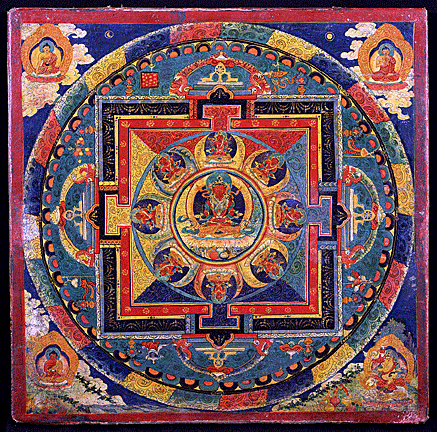 As
Buddhist monks traveled the Silk Road, a major trade route through
Asia, they brought Buddhism to many other lands. They carried
mandalas–-complex works of religious art—with them and brought the
practice of creating these works of art to other parts of Asia. The
earliest evidence of Buddhist mandala art dates to the first century
B.C.E. but appears in other regions, such as Tibet, China, and Japan
by the fourth century. Although rooted in Buddhism, mandalas later
became present in Hinduism, New Age Spirituality, and other
religious practices.
As
Buddhist monks traveled the Silk Road, a major trade route through
Asia, they brought Buddhism to many other lands. They carried
mandalas–-complex works of religious art—with them and brought the
practice of creating these works of art to other parts of Asia. The
earliest evidence of Buddhist mandala art dates to the first century
B.C.E. but appears in other regions, such as Tibet, China, and Japan
by the fourth century. Although rooted in Buddhism, mandalas later
became present in Hinduism, New Age Spirituality, and other
religious practices.
The earliest evidence of Buddhist mandala art dates to the first
century B.C.E. but appears in other regions, such as Tibet, China,
and Japan by the fourth century. Although rooted in Buddhism,
mandalas later became present in Hinduism, New Age Spirituality, and
other religious practices. Mandalas can be found in early Buddhist
art as early as the 14th and 15th centuries.
What Is a Mandala?
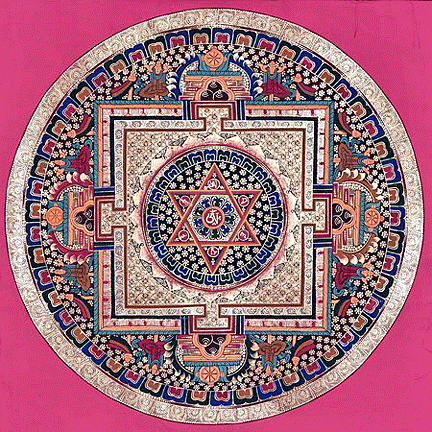 As
works of art, mandalas combine geometric patterns, religious
symbolism, and layers of meaning to create a masterpiece that’s a
symbol, a prayer, a meditation exercise, and a holy blessing all in
one. The name, mandala, comes from the Sanskrit word for circle and
refers to the sense of wholeness created by both circular forms.
Tibetan monks call a mandala Khyil-khor, which refers to the
center of all creation where a truly awakened being lives, taking
the meaning further than the Sanskrit reference.
As
works of art, mandalas combine geometric patterns, religious
symbolism, and layers of meaning to create a masterpiece that’s a
symbol, a prayer, a meditation exercise, and a holy blessing all in
one. The name, mandala, comes from the Sanskrit word for circle and
refers to the sense of wholeness created by both circular forms.
Tibetan monks call a mandala Khyil-khor, which refers to the
center of all creation where a truly awakened being lives, taking
the meaning further than the Sanskrit reference.
In Buddhism, mandalas represent the
ideal form of the universe. The act of creating a mandala represents
transformation of the universe from a reality of suffering to one of
enlightenment. While Tibetan Buddhists see the center of the mandala
as an awakened being at the center of the universe, the center also
represents the beginning of each person's journey toward knowledge,
wisdom, and enlightenment. Often, Buddhist monks use mandalas tools
to focus the mind during meditation.
 The
basic form of most mandalas is a square with four gates containing a
circle with a center point. Each gate is in the general shape of a
T. Mandalas often have radial balance.
The
basic form of most mandalas is a square with four gates containing a
circle with a center point. Each gate is in the general shape of a
T. Mandalas often have radial balance.
The mandala begins with the center of the design, radiating out with
symbols and designs as the pattern grows larger. They can be
painted, drawn, and even made from colorful sand. Those painted on
scrolls are often carried by travelers and pilgrims for a blessing
on the road and a focus for meditation as they travel.
Forms which are evocative of mandalas are prevalent in
Christianity—the Celtic cross, the rosary, the halo, the aureole,
oculi, the Crown of Thorns, rose windows, the Rosy Cross, and
the dromenon on the floor of Chartres Cathedral. The
dromenon represents a journey from the outer world to the inner
sacred centre where the Divine is found.
History of Mandalas
Through meditation and following a path of thought and action,
Siddhartha Gautama, the founder of Buddhism, attained enlightenment,
freeing himself from the cycle of death and rebirth. He taught this
path to his followers who still practice these principles today.
The Meaning of Mandalas
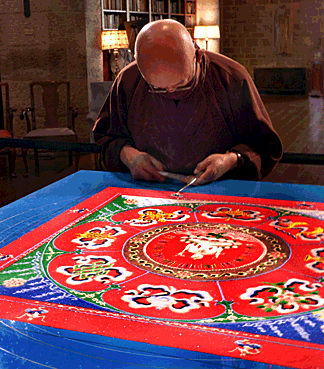 While
a finished mandala is important as a focus for meditation, the
creation process is equally important. A mandala has three layers of
meaning. The outer meaning represents the divine form of the
universe. The inner meaning creates a map to guide the mind to
enlightenment. The secret meaning, however, remains between the
artist and the creation as far as specific details. Overall it
represents a balance of body and mind infused with clarity.
While
a finished mandala is important as a focus for meditation, the
creation process is equally important. A mandala has three layers of
meaning. The outer meaning represents the divine form of the
universe. The inner meaning creates a map to guide the mind to
enlightenment. The secret meaning, however, remains between the
artist and the creation as far as specific details. Overall it
represents a balance of body and mind infused with clarity.
Often, mandalas include several key symbols of Buddhism. Among them
is the Wheel of Eight Spokes, the lotus flower, and bell shapes.
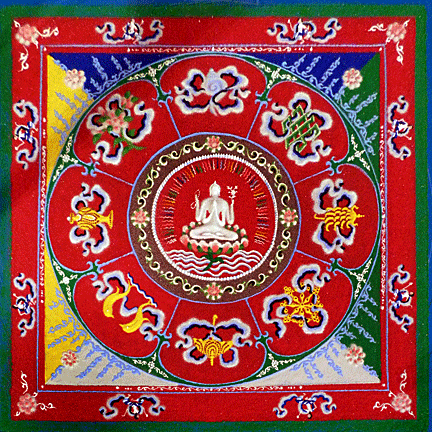 The
circular shape of the Wheel of Eight Spokes works well with the
artistic representation of a perfect universe. The eight spokes
represent the Eightfold Path of Buddhism which involves a series of
righteous thoughts and actions meant to guide someone to
enlightenment.
The
circular shape of the Wheel of Eight Spokes works well with the
artistic representation of a perfect universe. The eight spokes
represent the Eightfold Path of Buddhism which involves a series of
righteous thoughts and actions meant to guide someone to
enlightenment.
The lotus flower is one of the most sacred symbols in Buddhism. Its
symmetry represents balance. More importantly, the lotus reaches up
from its underwater, muddy bed to blossom in the light, much as a
human who reaches enlightenment.
Bell shapes appear in mandalas as a representation of openness and
the emptying of the mind to allow wisdom and clarity to enter.
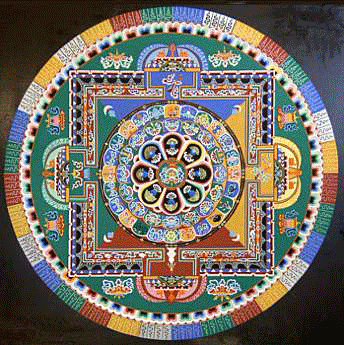 While
there are several kinds of mandalas, ones made of sand are unique in
that their meaning lies in both their creation and destruction. As a
meditation on impermanence (a central teaching of Buddhism), after
days or weeks of creating the intricate pattern of a sand mandala,
the sand is brushed together into a pile and spilled into a body of
running water to spread the blessings of the mandala.
While
there are several kinds of mandalas, ones made of sand are unique in
that their meaning lies in both their creation and destruction. As a
meditation on impermanence (a central teaching of Buddhism), after
days or weeks of creating the intricate pattern of a sand mandala,
the sand is brushed together into a pile and spilled into a body of
running water to spread the blessings of the mandala.
The mandala serves a conservative purpose—namely, to restore a
previously existing order. But it also serves the creative purpose
of giving expression and form to something that does not yet exist,
something new and unique. The process is that of the ascending
spiral, which grows upward while simultaneously returning again and
again to the same point.
Sometimes mandalas are associated with a symbolic palace. In the
centre of the mandala lies the palace, which has four gates oriented
to the four quarters of the world and is located within several
layers of circles that form a protective barrier around it.
Mount Meru
A mandala can also represent the entire universe, which is
traditionally depicted with Mount Meru as the axis of the world in
the center, surrounded by the continents. One example is the
Cosmological Mandala with Mount Meru, a silk tapestry from the Yuan
dynasty that serves as a diagram of the Tibetan cosmology, which was
given to China from Nepal and Tibet.
Wisdom and impermanence
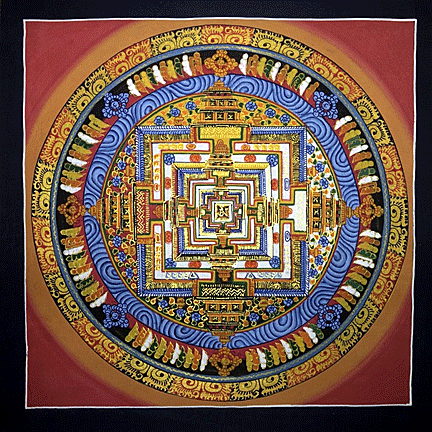 In
the mandala, the outer circle of fire usually symbolizes wisdom. The
ring of eight charnel grounds represents the Buddhist exhortation to
be always mindful of death, and the impermanence with which
samsara is suffused: "such locations were utilized in order to
confront and to realize the transient nature of life." Described
elsewhere, "within a flaming rainbow nimbus and encircled by a black
ring of dorjes, the major outer ring depicts the eight great
charnel grounds, to emphasize the dangerous nature of human life".
Inside these rings lie the walls of the mandala palace itself,
specifically a place populated by deities and Buddhas.
In
the mandala, the outer circle of fire usually symbolizes wisdom. The
ring of eight charnel grounds represents the Buddhist exhortation to
be always mindful of death, and the impermanence with which
samsara is suffused: "such locations were utilized in order to
confront and to realize the transient nature of life." Described
elsewhere, "within a flaming rainbow nimbus and encircled by a black
ring of dorjes, the major outer ring depicts the eight great
charnel grounds, to emphasize the dangerous nature of human life".
Inside these rings lie the walls of the mandala palace itself,
specifically a place populated by deities and Buddhas.
Five Buddhas
One well-known type of mandala is the mandala of the "Five Buddhas,"
archetypal Buddha forms embodying various aspects of enlightenment.
Such Buddhas are depicted depending on the school of Buddhism, and
even the specific purpose of the mandala. A common mandala of this
type is that of the Five Wisdom Buddhas, the Buddhas Vairocana,
Aksobhya, Ratnasambhava, Amitabha and Amoghasiddhi. When paired with
another mandala depicting the Five Wisdom Kings, this forms the
Mandala of the Two Realms.
